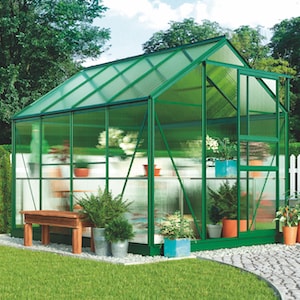What to do in your allotment in January
Written by Lee Senior
January promises exciting new beginnings and I can’t wait! My New Year’s Resolution is to spend more time at the allotment. Our plots can get a little forgotten about as we get caught up in the humdrum of everyday life, but I’m starting out with good intentions!
If you like to start your seeds off early in the season as I do, you’ll need a number of essential items: a heated propagator for seed germination (or a warm south-facing sunny windowsill), frost protection fleece, a small greenhouse heater (such as an Eco heater), cloches, and a cold frame for hardening off. I’ve grown early crops successfully in a cold greenhouse by using fleece or taking the plants into the house for the night when hard frosts are due. Try dividing off part of your greenhouse to create a cost-effective spring seedling section. Use a heater and apply bubble wrap to the inside of the windows to help maintain the required temperature in this smaller area.
Early crops are immensely rewarding from an achievement point of view. Anything that’s slightly ahead of the season is more expensive in the shops, so you’ll save money too. And don’t forget to order your seed potatoes if you haven’t already. They’ll be ready for chitting on a windowsill when they arrive through the post. Happy growing!
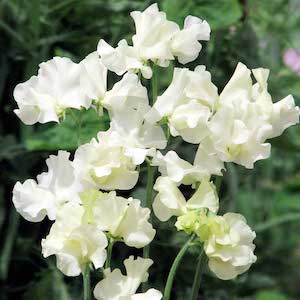
Image: Sweet Pea ‘Anne Gregg’
Allotment flowers in January
- Sow some early annual or perennial flower seeds this month. Frost protection is needed for all half-hardy plants and germination in gentle heat of around 18-22C is a requirement for many. Refer to the individual seed packets for exact requirements.
- Sow sweet pea seeds in a modular seed tray or a root trainer tray under cover, either indoors on a sunny windowsill or in the greenhouse. Use good quality seed compost, and make sure your seedlings neither dry out nor sit in waterlogged soil when they emerge.
- Dianthus ‘Sugar Baby Mix’ can also be sown towards the end of the month.
- One of my favourite perennials is the stunning delphinium which needs a long season to flower in the first year. Delphinium ‘Delight Mix’ should bloom in late summer from a late winter sowing, and is well worth the effort.
- Sow antirrhinums, lobelia and geraniums thinly in seed trays in a sheltered spot, either in the greenhouse or indoors. Treat your plants like annual bedding in the spring – plant them up in mixed containers to decorate the allotment.
Allotment vegetables in January
- Sow exhibition-size onion seed in the greenhouse or on a windowsill, using a seed tray or a clean margarine tub. These large bulbs require a long growing season to put on size. Try onion ‘Ailsa Craig’, or onion ‘Globo’ as well as the popular giant ‘Exhibition’.
- Garlic and shallots (from sets) can be planted indoors in rootrainers or small plant plots to allow for root development. They can be grown on in a cold greenhouse or cold frame until early spring.
- From the middle of January, sow early cropping carrot ‘Amsterdam Forcing 3’ directly into a polytunnel bed, or outdoors in unfrozen ground under a cloche. Crop the sweet roots in late March and into April.
- Sow early peas and super-hardy broad beans like ‘Aquadulce Claudia’ or ‘The Sutton’ now in rows in unfrozen ground outdoors on the plot. Cover with a cloche to protect seedlings from the worst of the cold and to warm the ground to speed up germination. Alternatively, sow your seed in trays on a sunny windowsill or in the greenhouse.
- Sow aubergine ‘Black Beauty’ seeds in a warm bright space. Ensure they stay at a temperature of 15 – 20 degrees celsius for successful germination.
- The white mooli radish ‘Neptune’ can be sown in January in gentle heat. It has a mild flavour and has excellent resistance to bolting. You can grow them on to maturity in large containers in a greenhouse at this time of year.
- I’ve successfully grown a number of sprouting seeds (micro-greens) over the years on a warm windowsill. My favourites include alfalfa, fenugreek, American cress, mustard and sprouting broccoli. For something a little different, wheatgrass shoots are packed with vitamins and make a good addition to a healthy smoothie. Harvest the grass when the second leaf emerges, about 10-14 days from sowing.
- Sow a mix of salad leaf seeds for a fresh harvest within three weeks. Sow salad ‘Winter Mix’ in a long deep container in the greenhouse or a sunny windowsill. Sow a new pot with salad seeds every couple of weeks for a continuous supply of fresh leaves through the first few months of the year.
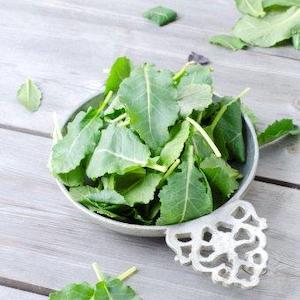
Image: Kale shoots seeds
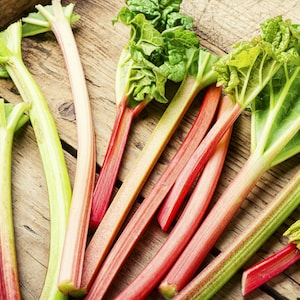
Image: Rhubarb ‘Victoria’
Allotment fruit in January
- Place forcing covers over your rhubarb crowns if they start showing signs of growth this month, to encourage long tender stems to start developing. Make your own forcing covers by repurposing a black plastic compost bin or an upturned rubbish bin with a few holes drilled in the top.
- Check your fruit tree ties this month. Tighten or loosen tree ties as needed.
- Provided the soil isn’t frozen or waterlogged, continue to plant bare-rooted fruit trees and bushes through January and February. Use a tree guard and support stake to brace your newly planted tree and protect it from damage by hungry deer and rabbits.
- Raspberry canes can also be planted during the dormant winter period.
- Now is a good time to prepare a new strawberry bed by clearing weeds and adding copious amounts of well-rotted organic matter. The beds will last for three years so good ground preparation is important while the soil is bare. Sow alpine variety strawberry ‘Regina’ seeds in a seed tray, or order strawberry plants if you prefer varieties with larger fruits.
Crops to harvest in January
- Keep cropping leeks, leaving them in the ground until you need them.
- Harvest brassicas like Brussels sprouts, kale, winter cabbages and cauliflower this month.
- Pull up root vegetables like swede and parsnip.
- Purple sprouting broccoli starts to crop this month! Enjoy the tender florets steamed with a knob of butter and a sprinkle of salt.
- Harvest the remainder of your Jerusalem artichokes.
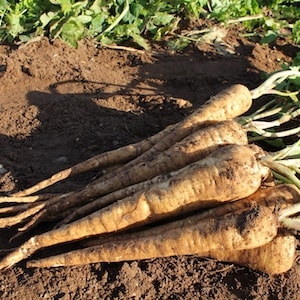
Image: Parsnip ‘F1 Panorama’
General January allotment jobs
- Have a go at growing your own mushrooms. Set up these kits indoors in a warm place away from direct sunlight. Choose from regular button mushrooms, to the more exotic oyster or shiitake to make your very own soups, stocks and pies.
- Invest in a heated propagator to speed up germination of seeds and allow seeds to be sown all year round.
- Buy necessary growing supplies for the coming year like fleece, compost and plant labels.
- Check on your stored potatoes, garlic, onions and shallots. Remove any that show signs of rot, or that are soft to the touch.
- Use the hard frozen ground as an opportunity to do some manual work on the plot. Shift manure, planks or erect compost bins while your plot is mud free. If the ground is soft and wet, then stay off it to avoid compaction.
- Review what worked in the allotment last year, and make a bed plan to keep organised. January is a great time to order vegetable seeds and plan out your crop rotation.
- Keep checking over allotment structures for wind damage. Check the netting on your brassicas to fix any holes and cover any exposed plants.
- Sharpen loppers, secateurs and pruning saws. Check over power tools and mowers – now’s the best time to conduct routine maintenance on garden machinery.
- It’s worth making regular checks on your sheds and outbuildings for any water ingress or weather damage throughout the winter. Problems that are spotted early are easier to deal with.
- Clean your greenhouse ready for the coming growing season.
Planning ahead
- Order your asparagus crowns for planting in February. Prepare your asparagus beds now by digging in deep ridges. Planting your crowns on top of the ridges will keep them free-draining, just as they like it.
- Order first early seed potatoes now ready for February planting. When they arrive, take them out of their container and lay them out somewhere cool and dry to ‘chit’ prior to planting.
- Order chilli seeds ready to sow next month. Choose a mix of heats, colours and growth habits to ensure you get a fun and versatile harvest in summer. Remember, the hotter the chilli, the longer the growth period it’ll need to develop a strong flavour.
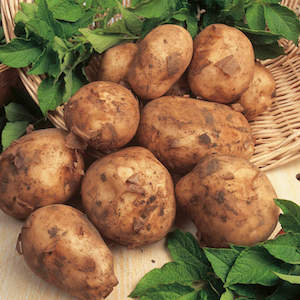
Image: Potato ‘Maris Bard’
Suttons Seeds recommend these areas which may also be of interest.
- Previous month: What to do in your allotment in December
- Next month: What to do in your allotment in February


